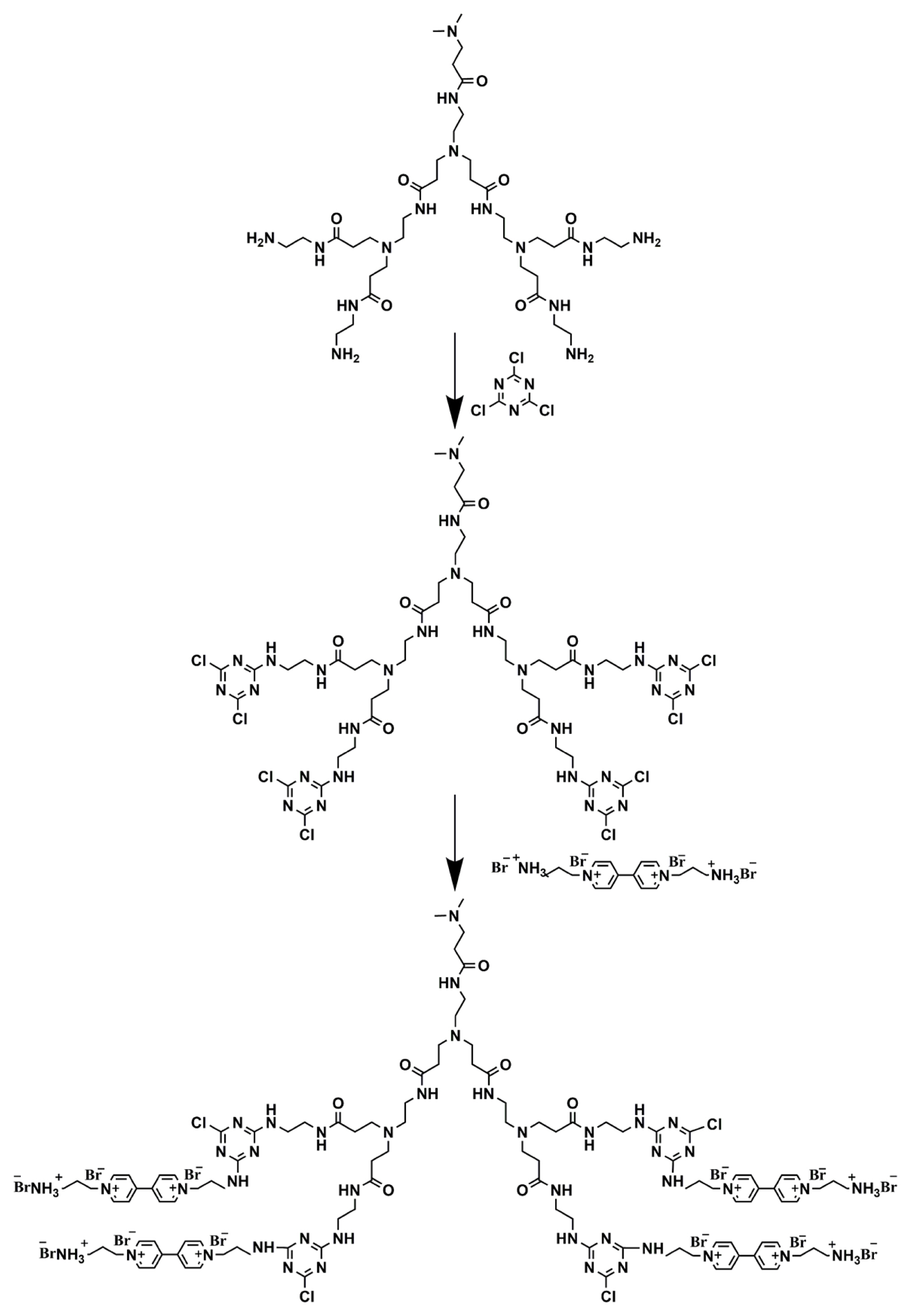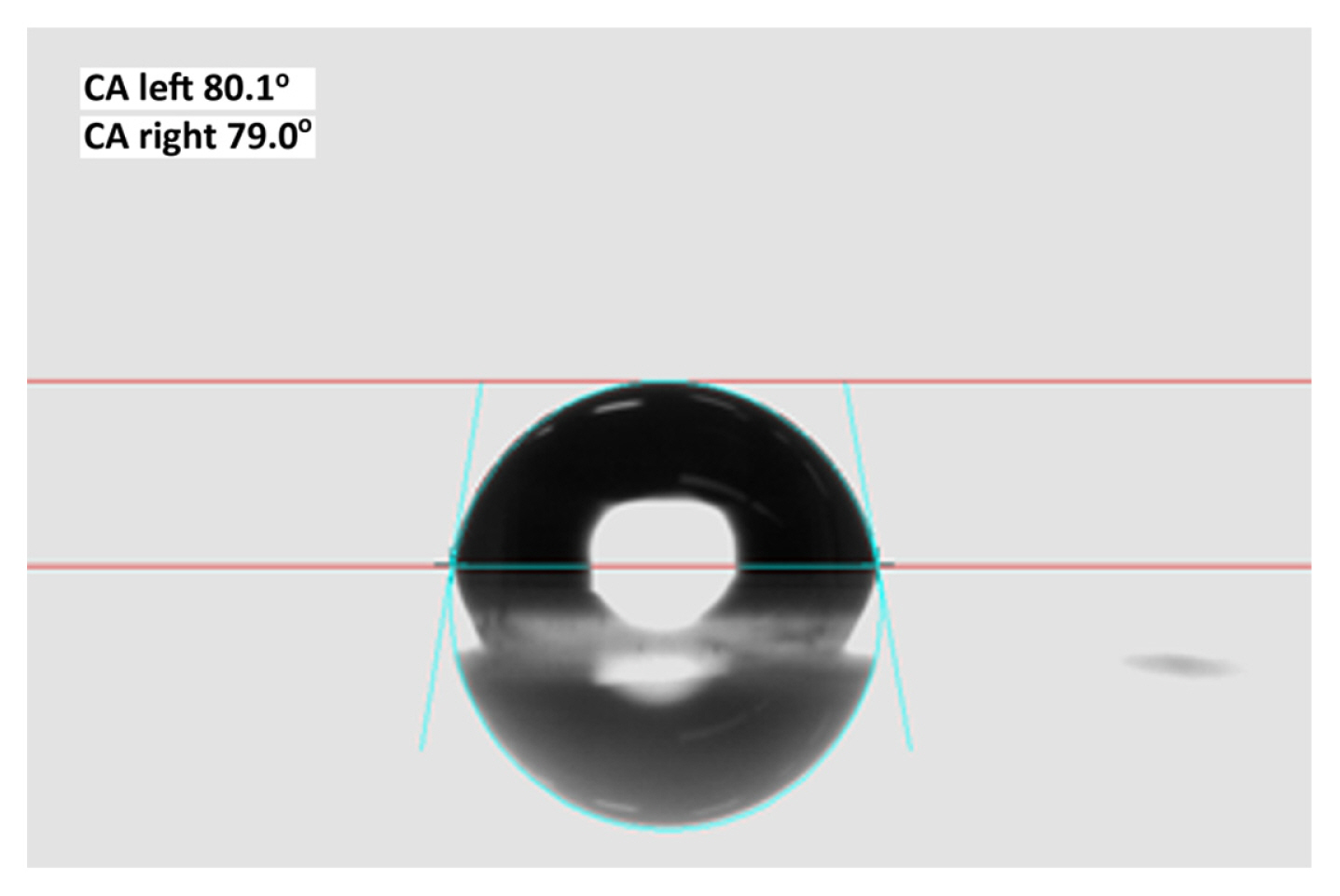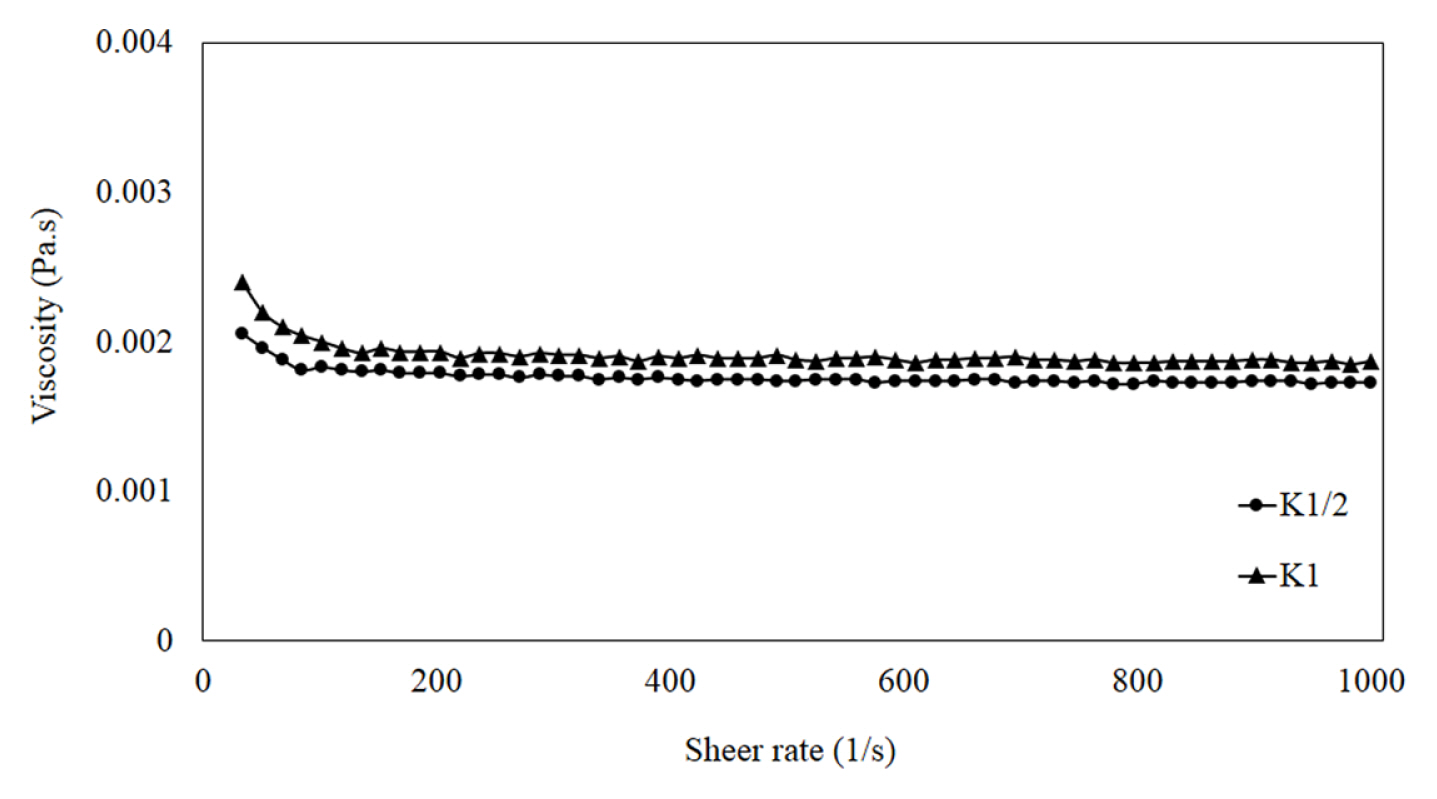 |
 |
- Search
| J. Electrochem. Sci. Technol > Volume 12(1); 2021 > Article |
|
Abstract
This paper reports the preparation of an ink-jet printed flexible electrochromic device based on a water-soluble viologenfunctionalized dendrimer. Polyamidoamine (PAMAM) dendrimers were modified with different concentrations of 1-1 bis(propylamine)-4,4ŌĆ▓-bipyridylium dibromides to obtain solution-processable electrochromic materials (K1/2 and K1). FTIR, NMR, and elemental analyses are used to characterize synthesized viologens. Moreover, their electrochemical properties were investigated using cyclic voltammetry in an electrolyte solution consisting of 0.1 M HCl to find the optimum viologens. The low-cost ink-jet printer was used to print the prepared water-soluble electrochromic inks onto the ITO coated PET substrate to form desired transparent patterns. The electrolyte was applied on the printed electrochromic ink to make a sandwich with another ITO coated PET to prepare the electrochromic devices (ECD). By applying an electrical potential (0 to ŌłÆ2 V), the transparent ECDŌĆÖs color changed from colorless to blue. The color changes for the optimum ECD (K1), which had more viologen units on the dendrimer, was accompanied by an optical contrast of 47% and 311.5 cm2CŌłÆ1 coloration efficiency at 600 nm.
Electrochromism is a phenomenon in which the materialŌĆÖs optical properties such as reflectance, transmittance, and absorbance are changed reversibly by applying a burst of charge. This phenomenon is associated with an electrochemically induced oxidation-reduction reaction in an electrochromic (EC) material [1,2]. The main classes of EC materials are the transition metal oxides, Prussian blue, metal coordination complexes, viologens, fullerenes dyes, and conducting polymers. A fabricated thin film of such EC materials was incorporated as a component of the EC device. Standard EC devices combine distinct layers between two transparent substrates (glass or PET). These different layers consist of optically transparent conductive oxide layers, typically indium-tin-oxide (ITO) as the electrodes coated on glass or PET substrate on either side of the device. The electrochromic (redox-active) material was printed on one of the conductive electrode substrates. A transparent conductive electrolyte (a pure ion conductor) in which an electron transfer occurs is characteristically located in the middle of the EC device, adjoining electrochromic material film, and conductive electrodes on the transparent conductive oxide coated glass or PET (Fig. 1). The device is typically sealed with the epoxy polymer and other sealants to avoid any leakage of electrolyte from the device.
In this study, the EC materials were synthesized based on the 4,4ŌĆ▓-bipyridinium, known as viologen. Advantages such as derivation with a short switching time, high stability, low-cost, and good applicability make these materials greatly desired [3,4]. There are three types of EC materials; types I, II, and III. The materials can be designed appropriately, such as to have different solubility levels, electrochemical properties, and a variety of colors. Type I viologen materials are soluble in their redox state. Type II viologen materials are soluble typically in their colorless state and produce a solid-colored film at the electrode surface after the electron transfer. Type III viologen materials are solid in all redox states during usage. Researchers have developed various viologen-functionalized materials [5ŌĆō7] such as viologen-modified nano-crystals [8ŌĆō12], viologen nano-composite [13], polymers containing viologen [14,15], dialkyl and diaryl viologens [3,12,16ŌĆō24], viologen-functionalized hyper-branched and viologen-functionalized dendrimer [16,25ŌĆō28], which have different solubility and EC device efficiency.
The efficiency of an EC device using aqueous viologen materials such as methyl viologens (type I) would be low since both the di-cationic and radicalcation states are very soluble [2,29]. Alternatively, neither small-molecule viologens nor the linear polymeric viologen derivatives are appropriate for fabricating an EC film, due to the high crystallinity of small-molecule viologens that produce opaque films and low solubility within linear polymeric viologen derivatives in most solvents, in particular, water[30]. It is necessary to design a viologen derivative to overcome such disadvantages for the application in flexible EC devices.
Previous studies [13,14,16,25ŌĆō28,31,32] have proven that using the bulky substituents instead of flat molecules in 4,4ŌĆ▓-bipyridyl was a more efficient method to synthesize water-soluble EC materials without the crystallinity issues [4,33ŌĆō35]. Therefore, in this study, the macromolecule PAMAM dendrimers [36,37] were selected to prepare novel water-soluble EC functional materials by attaching a viologen chromophore to end groups of polyamidoamine dendrimer branches. The main reasons for choosing these dendrimers are their relatively well-defined nanometer-scale sizes, good water-solubility, and the ability to be functionalized. Viologen-functionalized dendrimer materials consist of soluble dicationic species and soluble radical, cationic species.
EC materials are typically fabricated onto a substrate via a number of methods such as vacuum evaporation [38], sputtering [39], dipping or spray deposition [40], electrodeposition [41], electrochemical oxidation, chemical vapor deposition (CVD) [42], spin coating [43], screen printing, and ink-jet printing [43,44]. Research into the fabrication of various viologen-functionalized materials has focused overwhelmingly on high-temperature, vacuumed, and other conventional processes. In contrast, considerably less attention has centered on the printing processes. In this line of research, we look into the inkjet printing technique as a non-contact printing method to deposit a variety of materials as droplets directly onto the substrate. For this purpose, a viologen-functionalized dendrimer was used as an ink-jet ink to print onto a flexible film with minimal wastage of materials. A computer program controls the print and allows accurate replication with the ability to change images quickly and inexpensively. These features are difficult to achieve by using other methods.
Due to health and environmental concerns, solvent-based inks have been replaced by water-based inks to develop inks with better performance, lower printing costs, and less damage to both operator and environment. In this study, an attempt was made to prepare a water-based EC ink that can be fabricated onto flexible substrates by an ink-jet printer. The flexibility of the substrate permits soft handling and reduces the occurrence of damage during transport. The substrate is also lightweight, can be rolled, and is relatively thin, which makes it suitable for incorporation into windows (construction), sunroofs (automobiles), and even curved glass surfaces (household wares). The present study was conducted to identify the application of ink-jet printing technology as a replacement for high-temperature processes and other conventional methods in the manufacture of flexible EC devices. Smart water-based inks as an environmental bonus were printed on the flexible ITO-coated PET to make EC devices.
In this study, 4,4ŌĆ▓-bipyridine was provided by Alfa Aesar Company. 3-Bromo propylamine hydrobromide 98% was supplied by Sigma-Aldrich Company, and 2,4,6-trichloro-s-triazine (cyanuric chloride) was purchased from Merck Company, Germany. The preparation of ethylenediamine core polyamidoamine dendrimer of (PAMAM G2) is described within reference [45]. DuPont Company, Germany, provided polymethyl methacrylate. Propylene carbonate and a binary mixture of ethylene poly(oxide) and propylene poly(oxide) (PEO-PPO) were purchased from Fluka Company, Germany. The polyethylene glycol 200, isopropyl alcohol, lithium perchlorate, tetrahydrofuran (THF), and all the other chemicals used during this work were chosen as they are laboratory grade, being received from Merck Company, UK. The Sigma-Aldrich Company, USA, provided the indium tin oxide (ITO) coated polyethylene terephthalate (PET) with a surface resistivity of 60 WsqŌłÆ1 and thickness of 127 mm.
The prepared EC ink was ink-jet printed using an Epson Stylus Photo P50 printer. The pH, surface tension, and viscosity of the prepared water-based inks were characterized using 827 pH Metrohm meters (Herisau/Switzerland), Tensiometer K100MK2 (Hamburg, Germany), and Brookfield DVII (New Jersey, USA), respectively. The prepared ink was filtered through 0.45 and the 0.2╬╝m Sartorius Minisart filter (G├Čttingen, Germany). Static contact angle (╬Ė) and surface energy of the substrate were measured by a Kruss G40-type contact angle measuring system using distilled water as the probe liquid at temperature and humidity of 25┬░C and 30%, respectively. For this purpose, a small drop of distilled water (2ŌĆō3 mL) was exposed to the surface of the substrates. The test was done in triplicate, and the average of the measurements was reported. An image analysis system (G2/G40) was used to calculate the contact angle values. Thin-layer chromatography (TLC) was performed using aluminum plates coated with silica gel 60 F254 (Merck) as a stationary phase and a mixture of isobutanol: n-propanol: ethyl acetate: water in the ratio 2:4:1:3 as the mobile phase. The developed plates were visualized under both short and long-wavelength ultraviolet light (254 nm, 365 nm). The Fourier transformed infrared spectroscopy (FTIR) spectrums of synthesized electrochromic dyes were recorded on Bruker (IFS-48) (Bruker Optik GmbH, Germany), in the range of 400 to 4000 cmŌłÆ1. The synthesized electrochromic dyes were characterized by proton nuclear magnetic resonance (1H NMR) spectra, which were recorded on a Bruker-SY200-250 MHz spectrometer analyzer. The gel permeation chromatography (GPC) was performed on a Shimadzu 6-A with the column model Waters Ultrahydrogel 250, which was fitted by water as the mobile phase (flow rate 1 mL┬ĘminŌłÆ1) and PEG as standard material to determine the molecular weight of previously synthesized PAMAM dendrimer. Elemental analyses for carbon, hydrogen, nitrogen, and sulfur were carried out at the Central Laboratory, Tehran University, on an Eager 300 for EA1112. In the cyclic voltammetry, a three-electrode method was adapted with platinum wire, glassy carbon (3 mm diameter), and Ag/AgCl as the counter, working, and reference electrodes, respectively. A cyclic voltammetry experiment was performed by cycling the potential of a working electrode and measuring the resulting current. In the preparation process for the CV experiment, a glassy carbon as a working electrode was polished with a 1 ╬╝m and 0.1 ╬╝m ╬│-Al2O3 polishing cloth for 5 minutes. Polishing was followed with 3 minutes of sonication in water to ethanol mixture (1:1). Background voltammograms were obtained in 0.1 M HCl saturated electrolyte by cycling the potential between 0 to ŌłÆ1.4 V. Absorbance measurements at lmax using UV Ikon 923 Double Beam UV/Visible spectrometer (Saint-Quentin-Yvelines, France) determined the electrochromic characterizations of novel ECDs that contain newly synthesized viologen-functionalized dendrimer.
Epson Stylus Photo P50 ink-jet printer was used to print a solid square pattern by the water-based ink formulation containing 100 g/dm3 synthesized viologen-functionalized dendrimers (K1 or K1/2), 50 g/dm3 polyethylene glycol 200, and 300 g/dm3 isopropyl alcohol. The inks were made up to 1 dm3 with de-ionized water. Epson Stylus Photo P50 ink-jet printer operated using a piezoelectric squeeze mode print head that squirts ink droplets through a nozzle with a 65-╬╝m opening. Printing was carried out at pH=6 using a buffer solution to prevent damage to the print-head and cartridge. The prepared inks were filtered by 0.45 ╬╝m and 0.2 ╬╝m filters to prevent the nozzles clogging. The ink-jet printing substrate was an ITO coated PET. The ITO coated PET was cleaned using an ultrasonic bath in de-ionized water, isopropyl alcohol, acetone, and methanol, respectively. The methanol is an effective solvent and provides a higher surface energy substrate. Finally, the cleaned ITO coated PET dried at 60┬░C for 2 hours before loading inside the printing system.
During the preparation of ink-jet printing of flexible ITO coated PET substrates, a new and cleaned cartridge was filled with filtered formulated ink. Subsequently, the filled cartridge was located inside the printer. The printed ITO coated PET dried at 130┬░C for 30 minutes.
Within electrolyte preparation, polymethyl methacrylate (PMMA) (0.36 g), lithium perchlorate LiClO4 (0.33 g), a binary mixture of ethylene poly(oxide) and propylene poly(oxide) (PEO-PPO) (0.21 g), and propylene carbonate (PC) (1.75 g) were mixed with 4 mL of THF and followed by stirring for about 4 hours to obtain transparent uniform lightly viscous gel [46]. The prepared gel electrolyte was used as an ion conductor layer between the counter and working electrodes in the EC device.
The 1-1-bis(propylamine)-4,4ŌĆ▓dipyridyl viologen derivative (Fig. 2) was synthesized via the reaction of 3-bromo propylamine hydrobromide with 4,4ŌĆ▓-bipyridine in an aqueous solvent. Thus, 3-bromo propylamine hydrobromide (0.2 mol, 43.78 g), and 4,4ŌĆ▓-bipyridine (0.1 mol, 15.619 g) dissolved in 200 mL distilled water, and the pH of the solution adjusted to 5 via the addition of dilute hydrochloric acid. The reaction mixture was refluxed at 100┬░C for 2 hours to yield a pale yellow solution. During the reaction, the pH value of the solution was adjusted with Na2CO3. The mixture stirred at pH 5 with control by TLC, and the resulting yellow product, 1-1-bis(propylamino)-4,4ŌĆ▓dipyridyl viologen derivative, was precipitated from the solution via the addition of acetone. The powder was dried at 40┬░C in a vacuum oven overnight, Yield: 44.5 g (75% yield). The product was homogeneous as judged by TLC, 1H NMR (250 MHz; D2O, ppm): 2.5 (E), 3.1 (D), 4.8 (F), 8.5 (B), and 9.1 (A) (Fig. 3a).
FT-IR (KBß╣ø, ßĮ║ max/cmŌłÆ1): 3697 (ŌłÆOH water), 3065 (ŌłÆCH aromatic), 2987 (ŌłÆCH aliphatic), 1643 (ŌłÆNH), 1562 (C-C=C aromatic resonance), 1474 (ŌłÆCH aliphatic), and 1279 (aromatic amine) (Fig. 3b)
Regularly, the product is an isolate containing an impurity. Mole In (MI) represents the weight in grams of the synthesized material, in question within 1 mol of ŌĆ£pureŌĆØ synthesized material. The MI and purity were determined by elemental analysis. Calc. for C16H24N4: C, 70.56%; N, 20.59%. Found: C, 55.8%; N, 16.6%, corresponded to purity 79.5%, MI=342.
In the first step, the purity and MI of the PAMAM dendrimer have been calculated using gel permeation chromatography (GPC): Calc for C142H288N58O28 =3256, Found MI:3565 that corresponded to purity (91%).
Surface-primary amino groups of PAMAM G2 dendrimer was used as nucleophile agents to react with different molar ratios of 2,4,6-trichloro-s-triazine (1:8 and 1:16 of PAMAM G2 to 2,4,6-trichloro-s-triazine). A suspension of freshly 2,4,6-trichloro-s-triazine, which cooled in an ice bath added drop-wise into a solution of PAMAM dendrimer at 0┬░C and pH~5ŌĆō6. It was possible to substitute a first triazine chlorine atom with the surface primary amino functions that are conducing to PAMAM-triazine derivatives (Fig. 4). Reaction progress was followed by the release of hydrochloric acid and the reduction of pH, which was controlled by adding Na2CO3. The mixture was stirred at pH~5ŌĆō6 with control via TLC. Finally, the dendrimer surface was modified using alternative ratios of 2,4,6-trichloro-s-triazine that were highly reactive, thus, forcing the next step to be initiated immediately.
1-1-bis(propylamino)-4,4ŌĆ▓-bipyridylium (v2+) dissolved in de-ionized water with different molar ratios 8:1 and 16:1 of v2+ to PAMAM G2, and then introduced drop-wise into the PAMAM-triazine reaction mixture. The amino groups in v2+ as nucleophile agents reacted with PAMAM-triazine at 40┬░C and pH~5ŌĆō6. The pH of the reaction was controlled by adding Na2CO3. The reaction mixtures were stirred overnight, followed by isolating the colored yellow powder by acetone. The powder was placed in the freeze dryer at ŌłÆ37┬░C overnight. The products with molar ratios 16:1 and 8:1 of v2+ to PAMAM G2 were called K1 and K1/2, respectively.
1H NMR (250 MHz; D2O, ppm): 2.1 (G), 2.5 (H.E), 2.7 (K), 3.1 (D), 3ŌĆō3.5 (I), 4.8 (F), 8.5 (B), 9.1 (A) (Fig. 5a and Fig. 5b). The percentage of terminal amino groups of the dendrimer was calculated by integrated 1H NMR intensities, wherein functionalized viologens were 82% of the dendrimer branches in K1 and 40% in K1/2. 1H NMR spectrum of dendrimers exhibited significantly broadened peaks. FTIR (KBr, ßĮ║ max/cmŌłÆ1): 3429 (hydrogen bonds), 3285 (ŌłÆNH), 3064 (ŌłÆCH aromatic), 2966 (ŌłÆCH aliphatic), 1645 (ŌłÆNH-C=O amide), 1550 (C-C=C aromatic resonance), 1433 and 1365 (ŌłÆCH aliphatic), 1275 (aromatic amine), 584 (C-Cl) (Fig. 5c).
MI and purity by elemental analysis for K1/2: Calc. for C294H464N114O28Cl8, C, 55.8%; N, 25.2%. Found: C,33.8% ; N, 15.27%, corresponds to purity 60.5%, MI=10452.
MI and purity by elemental analysis for K1: Calc. for C448H640N170O28Cl16, C, 56.96%; N, 25.33%. Found: C,34.1% ; N, 14.14%, corresponds to purity 57.9%, MI= 16234
The cyclic voltammetry (CV) measurements were performed to examine the existence of the reversibility and redox behavior of newly synthesized viologen derivatives.
The CVs of viologen-functionalized dendrimers (K1 and K1/2) illustrate in Fig. 6aŌĆōFig. 6b. The electrochemical parameters are given in Table 1. As it can be seen, both CVs exhibited oxidation-reduction waves. A sharp peak appeared with a peak potential wave of E= ŌłÆ0.67 V for K1, corresponding to the first reduction of dicationic viologen (V2+) to mono-cation radical (V+ŌĆó) as deep-blue color. Doubly reduced viologen (V2ŌĆó) at ŌłÆ1.0 V was formed according to the color changes from deep blue to a colorless state. The first oxidation occurred at ŌłÆ0.91 V with a change of colorless to blue during the formation of mono-cation radical (V+ŌĆó).
As expected, K1/2 showed the same CV with peak potential wave of E= ŌłÆ0.65 V, corresponding to the first reduction of di-cationic viologen (V2+) to monocation radical (V+ŌĆó) as deep-blue color. Doubly reduced viologen (V2ŌĆó) at ŌłÆ0.99 V formed according to color changing from deep blue to colorless state as the same as K1. The first oxidation occurred at ŌłÆ0.91 V with a change of colorless to blue during the formation of mono-cation radical (V+ŌĆó). Detrimental changes did not observe for the initial and second reduction and oxidation potentials. These results show that the origins of redox potential are related to the same molecule of viologen on dendrimer.
As expected, a transition from a deep blue to a colorless state occurred during the second oxidation related to the oxidation of mono-cation radical to dication (V2+) form.
The values of peak potential separation (╬öEp) for K1 and K1/2 were 90 mV and 80 mV, respectively. Suggesting that the electron transfers in K1 and K1/2 were quasi-reversible [47ŌĆō49].
The voltammograms also were recorded by changing the scan rates from 0.05 VsŌłÆ1 to 0.5 VsŌłÆ1 (Fig. 6c). The peak current ratios (Ipc/Ipa) ranging from 0.05 VsŌłÆ1 to 0.5 VsŌłÆ1 were found to be very near to unity, which implies that the system was quasi-reversible for both K1 and K1/2. Increasing peak current at the same condition for K1 concerning K1/2 has approved the addition of more viologen units on the dendrimer, which is responsible for the production of more reduction and oxidation currents.
The wettability of the ink on a substrate depends on the substrateŌĆÖs surface energy and the inkŌĆÖs surface tension. Therefore, before starting to develop the inkjet inks, the surface energy of the substrate should be considered to prepare an ink with lower surface tension than the substrateŌĆÖs surface energy[50].
The surface energy values of the ITO coated PET calculated according to equations (1) and equation (2), which are known as the equations of state as proposed by Li and Neumann [51].
where ╬│lv and ╬│sv are surface tension of water and surface energy of the substrate, respectively. ╬Ė is a water contact angle and b is 0.0001247 ┬▒0.000010 (mJ/m2)ŌłÆ2. The work of adhesion (WA) was first calculated according to equation (1) (YoungŌĆÖs equation). Surface energy (╬│sv) was then calculated using equation (2).
Based on Fig. 7, the water contact angle on the ITO coated PET is 79.5┬░. According to the above equations, the surface energy values of ITO coated PET was 35.8 mNmŌłÆ1. Correspondingly, the surface tension of the prepared inks plays significant roles in the wettability of the ink onto the substrate and in the decomposition of the ink into precise drops through the printerŌĆÖs nozzle. The surface tension values of the formulated inks were 29.9 mNmŌłÆ1 and 30.1 mNmŌłÆ1, respectively. The results were within the values of commercial ink-jet ink (28ŌĆō31 mNmŌłÆ1) and lower than the obtained surface energy of the substrate (35.8 mNmŌłÆ1).
The viscosity of the prepared ink mainly affects the rheological performances within the capillary nozzles of the printer. Fig. 8 shows the variation of viscosities along with shear rates for the prepared water-soluble inks on a logarithmic scale. As can be seen, the viscosity of the inks remained almost unchanged by increasing the shear rate, demonstrating that the inks behave as a Newtonian fluid [52]. Consequently, the viscosity value for the ink-jet ink was 1.8 mPa.s, which is within the acceptable range for ink-jet printing ink.
The flexible EC devices are assembled in a multilayer structure due to investigate the electrochromic properties of synthesized EC material as an active printed layer in an EC device. First, the homogeneous and thin layers of EC materials based on novel water-soluble viologen-functionalized dendrimers (K1/2 and K1) ink-jet printed on the ITO coated PET substrate. Then, the electrolyte that was previously prepared was spilled onto the printed EC film to facilitate the movement of ions between each electrode. Subsequently, an extra ITO coated PET substrate was used as a counter electrode placed on top of it and combined in a sandwich structure (Fig. 1). The connection was reinforced using a clip with dimensions of 2.5 cm ├Ś 3.5 cm. The electrolyte inside the device needed not to contain air bubbles, because their presence may interfere in the measurements.
Then, the EC device color changes were examined by UV-Vis spectroscopy (Fig. 9a and Fig. 9b) at various applied potentials. In the initial state (0 V), when the viologen di-cation formed, the prepared EC devices were colorless. By applying the potential, the electrochemical reduction obtained in the formation of the radical cation and EC device color changes from the transparent to blue occurred (Fig. 9c) with the absorption of broadband centered at ╬╗max= 550 nm and 600 nm for K1/2 and K1, respectively. By increasing the applied potential from ŌłÆ1 V to ŌłÆ1.5 V and ŌłÆ2 V, color absorption intensity in ╬╗max increased. The absorption at ╬╗max= 600 nm for K1 indicates the formation of viologen cation radical monomers, while its associated species or dimeric forms are at ╬╗max= 550 nm [25]. A great way to assess the insertion/extraction film is to compare spectral coloration efficiencies, CE (╬╗), for the visible region.
Coloration efficiency is defined as the amount of electronic charge (Q), which is necessary to produce an optical density change (ΔOD), equation (3).
╬öOD (╬╗max) is the change in transmitted optical density at the maximum wavelength (single-pass) because of charge density Q (cm2 CŌłÆ1) inserted to the Tb (bleached transmittance value) and Tc (colored transmittance value). The best prepared EC deviceŌĆÖs coloration efficiency (╬Ę) or electrochromic efficiency (EE) was 311.5 cm2CŌłÆ1 at 600 nm in ŌłÆ2 V potential. The redox process was reversible, and the coloration-decoloration switching time was 5 seconds. Color contrast for the prepared EC device was the transmittance change from 79.2% (0 V) to 32.2% (ŌłÆ2 V) at ╬╗max= 600 nm (╬öT= 47%), Table 2.
The obtained results were comparable to previous reports [8,20,53ŌĆō59]. However, the switching time value was longer than that obtained in the ECD based on type II electrochromic materials. This difference was due to the diffusional limitation of the solution based viologen-functionalized dendrimer system.
Water-soluble novel electrochromic materials were prepared based on viologen-functionalized dendrimer (K1 and K1/2). From the cyclic voltammetry (CV) measurement results, the best synthesized viologenfunctionalized dendrimer that had more viologen units on the dendrimer was K1. The water-based inkjet inks that contained the novel synthesized electrochromic materials (K1 and K1/2) were ink-jet printed onto the ITO coated PET to make flexible EC devices. The EC devices with a gel polymeric electrolyte based PMMA showed a change in color from colorless to blue of various intensities at the increasingly applied potential. The EC device demonstrated acceptable electrochromic properties with switching time 5 seconds in alternate cycles. The results of the K1 and K1/2 electrochromic properties proved that the EC device was prepared by K1 to be the optimal device. The color changes of the optimal EC device showed an optical contrast of 47% and a coloration efficiency of 311.5 cm2CŌłÆ1 at 600 nm. The transmittance of the EC device at 600 nm can be changed reversibly from 79.2% (bleached) to 32.2% (darkened), with applied potentials of 0 and ŌłÆ2 V, respectively. Therefore, a water-based electrochromic inkjet ink that has no contamination to humans, and no environmental risk was formulated and successfully printed to prepare flexible electrochromic devices. Assembling an all-polymeric flexible electrochromic device in the form of a film, opens the perspective of applying these films on a flat or curved substrate.
Notes
Fig.┬Ā5
a) 1H NMR spectra of K1 in D2O, b) 1H NMR spectra of K1/2 in D2O c) FT-IR of spectra K1(line) and K1/2 (dash).
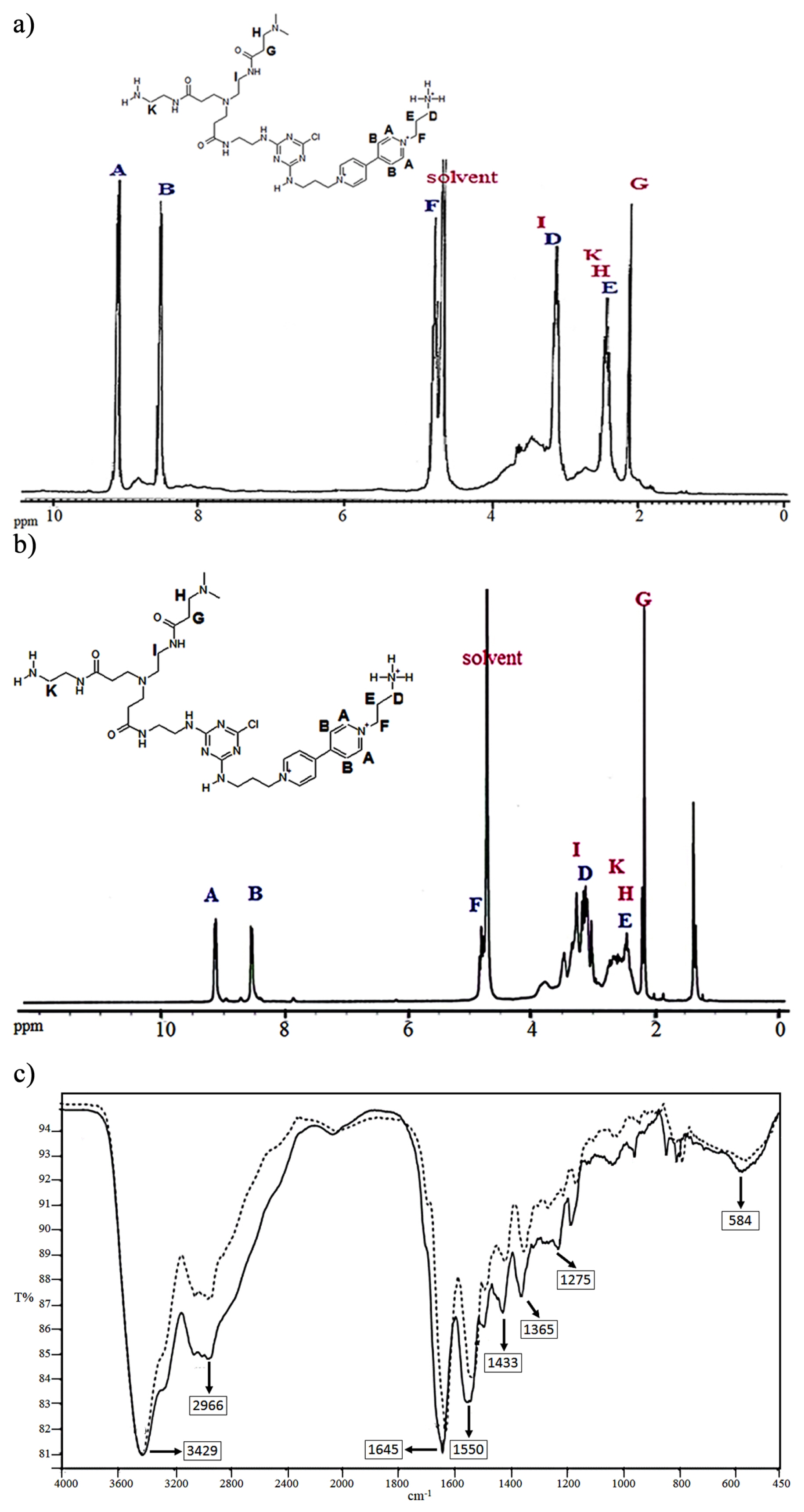
Fig.┬Ā6
Cyclic voltammogram of the viologen-functionalized dendrimer (V2+)x(NH2)16-x, a) K1 and b) K1/2 in aqueous 0.1 M HCl at a glassy carbon working electrode, scan rate varies from 0.05 to 0.5 VsŌłÆ1, c) Plot of peak current vs. SQRT of scan rate for the first oxidation and reduction peaks.
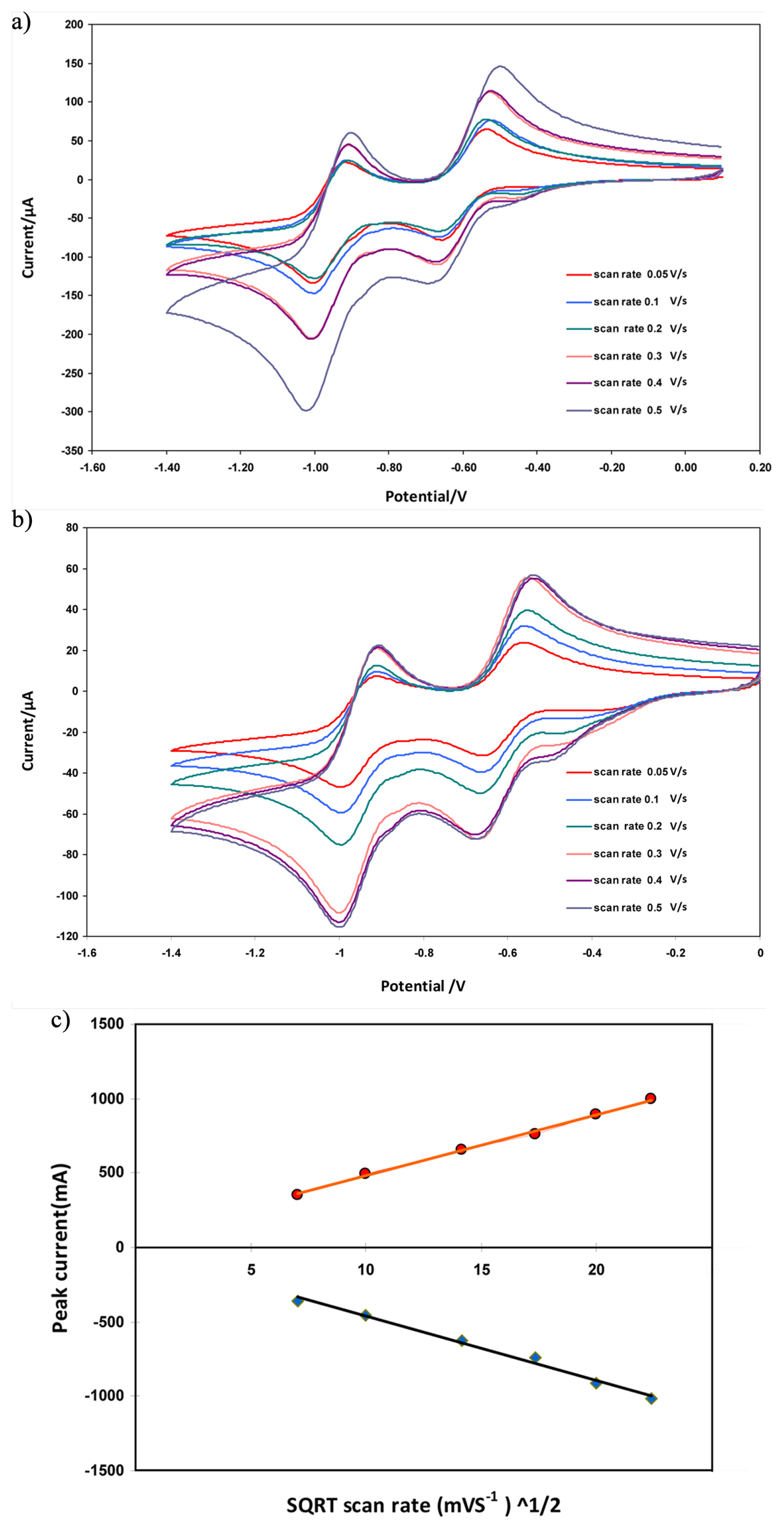
Fig.┬Ā9
a) Absorption spectra for ECD (K1/2) in different potential b) absorption spectra for ECD (K1) in different potential. c) Absorption spectra for ECD K1(line) and K1/2 (dash) in different potential.

Table┬Ā1
Electrochemical parameters for K1 and K1/2
| Sample | ER1(V) | ER2 (V) | EOX1 (V) | EOX2 (V) | ΔEp(mV) |
|---|---|---|---|---|---|
| K1 | ŌłÆ0.67 | ŌłÆ1.0 | ŌłÆ0.91 | 0.54 | 90 |
| K1/2 | ŌłÆ0.65 | ŌłÆ0.99 | ŌłÆ0.91 | 0.57 | 80 |
Table┬Ā2
Electrochromic properties of K1 and K1/2 devices
| Sample | ╬╗maxa/nm | Abb | ╬ö%T | Ac(mA) | (TC)d | (Tb)e | ╬öODf | (EE)g Cm2CŌłÆ1 |
|---|---|---|---|---|---|---|---|---|
| K1/2 | 550 | 0.97 | 38.6 | 6 | %40.6 | %79.2 | 0.66 | 192.5 |
| K1 | 600 | 1.60 | 47.0 | 5 | %32.2 | %79.2 | 0.89 | 311.5 |
References
[1] GC. Granqvist, Handbook of inorganic electrochromic materials, 1995.
[2] PMS. Monk, RJ. Mortimer and DR. Rosseinsky, Electrochromism: fundamentals and applications, 1995.

[5] J. Ding, C. Zheng, L. Wang, C. Lu, B. Zhang, Y. Chen and X. Zhuang, J Mater Chem A, 2019, 7(41), 23337ŌĆō23360.

[11] D. Corr, U. Bach, D. Fay, M. Kinsella, C. McAtamney, F. OŌĆÖReilly, SN. Rao and N. Stobie, Solid State Ion, 2003, 165(1), 315ŌĆō321.

[16] T. Sakano, F. Ito, T. Ono, O. Hirata, M. Ozawa and T. Nagamura, Thin Solid Films, 2010, 519(4), 1458ŌĆō1463.

[17] TM. Benedetti, T. Carvalho, DC. Iwakura, F. Braga, BR. Vieira, P. Vidinha, J. Gruber and RM. Torresi, Sol Energy Mater Sol Cells, 2015, 132, 101ŌĆō106.

[20] HJ. Byker, US Pat No 5,336,448. 1994.
[23] SG. Bertolotti, JJ. Cosa, HE. Gsponer, M. Hamity and CM. Previtali, Can J Chem, 1986, 64(5), 845ŌĆō848.

[24] S. Nachimuthu, WR. Shie, DJ. Liaw, RV. Romashko and JC. Jiang, J Phys Chem B, 2019, 123(22), 4735ŌĆō4744.

[26] K. Takada, DJ. D├Łaz, HD. Abru├▒a, I. Cuadrado, C. Casado, B. Alonso, M. Mor├Īn and J. Losada, J Am Chem Soc, 1997, 119(44), 10763ŌĆō10773.

[28] S. Araki, K. Nakamura, K. Kobayashi, A. Tsuboi and N. Kobayashi, Adv Mater, 2012, 24(23), OP122ŌĆōOP126.

[29] P. Monk, The Viologens: Synthesis, Physicochemical Properties and Applications of the Salts of 4, 4ŌĆ▓-Bipyridine, 1998.
[36] P. Bhattacharya, A Novel Series of Viologen-Containing Dendrimers, 2008.
[40] KX. Steirer, MO. Reese, BL. Rupert, N. Kopidakis, DC. Olson, RT. Collins and DS. Ginley, Sol Energy Mater Sol Cells, 2009, 93(4), 47ŌĆō453.
[41] SM. Wang, L. Liu, WL. Chen, ZM. Zhang, ZM. Sua and EB. Wang, J Mater Chem A, 2013, 1(2), 216ŌĆō220.

[45] R. Esfand and D. Tomalia, Laboratory synthesis of poly (amidoamine)(PAMAM) dendrimers. Dendrimers and other dendritic polymers, 2001.

[46] E. Fortunato, Dual-phase inkjet printed electrochromic layers based on PTA and WOX/TiO2 nanoparticles for electrochromic applications, 2010.
[47] K. Wadhwa, S. Nuryyeva, AC. Fahrenbach, M. Elhabiri, C. Platas-Iglesias and A. Trabolsi, J Mater Chem C, 2013, 1(12), 2302ŌĆō2307.

[49] AH. Holm, R. MŌŖśller, KH. Vase, M. Dong, K. Norrman, F. Besenbacher, SU. Pedersen and K. Daasbjerg, New J Chem, 2005, 29(5), 659ŌĆō666.

[50] HR. Kang, J Imaging Sci, 1991, 35(3), 179ŌĆō188.
[52] HF. George and F. Qureshi, NewtonŌĆÖs Law of Viscosity, Newtonian and Non-Newtonian Fluids. Encyclopedia of Tribology, 2013.

[53] HJ. Byker, US Pat No 5,294, 376A. 1994.
[55] S. Li, Y. Wang, JG. Wu, L. Guo, M. Ye, YH. Shao, R. Wang, C. Zhao and A. Wei, RSC Adv, 2016, 6(76), 72037ŌĆō72043.

[57] V. Jain, M. Khiterer, R. Montazami, HM. Yochum, KJ. Shea and . JRH, ACS Appl Mater Interfaces, 2009, 1(1), 83ŌĆō89.

[58] CW. Hu, KM. Lee, KC. Chen, LC. Chang, KY. Shen, S-C. Lai, T-H. Kuo, C-Y. Hsu, LM. Huang, R. Vittal and KC. Ho, Sol Energy Mater Sol Cells, 2012, 99, 35ŌĆō140.
- TOOLS







